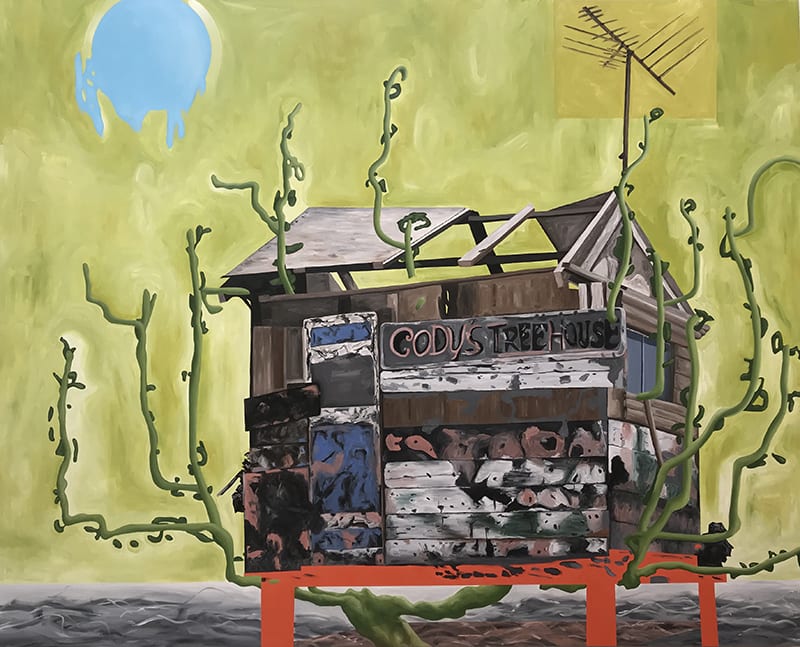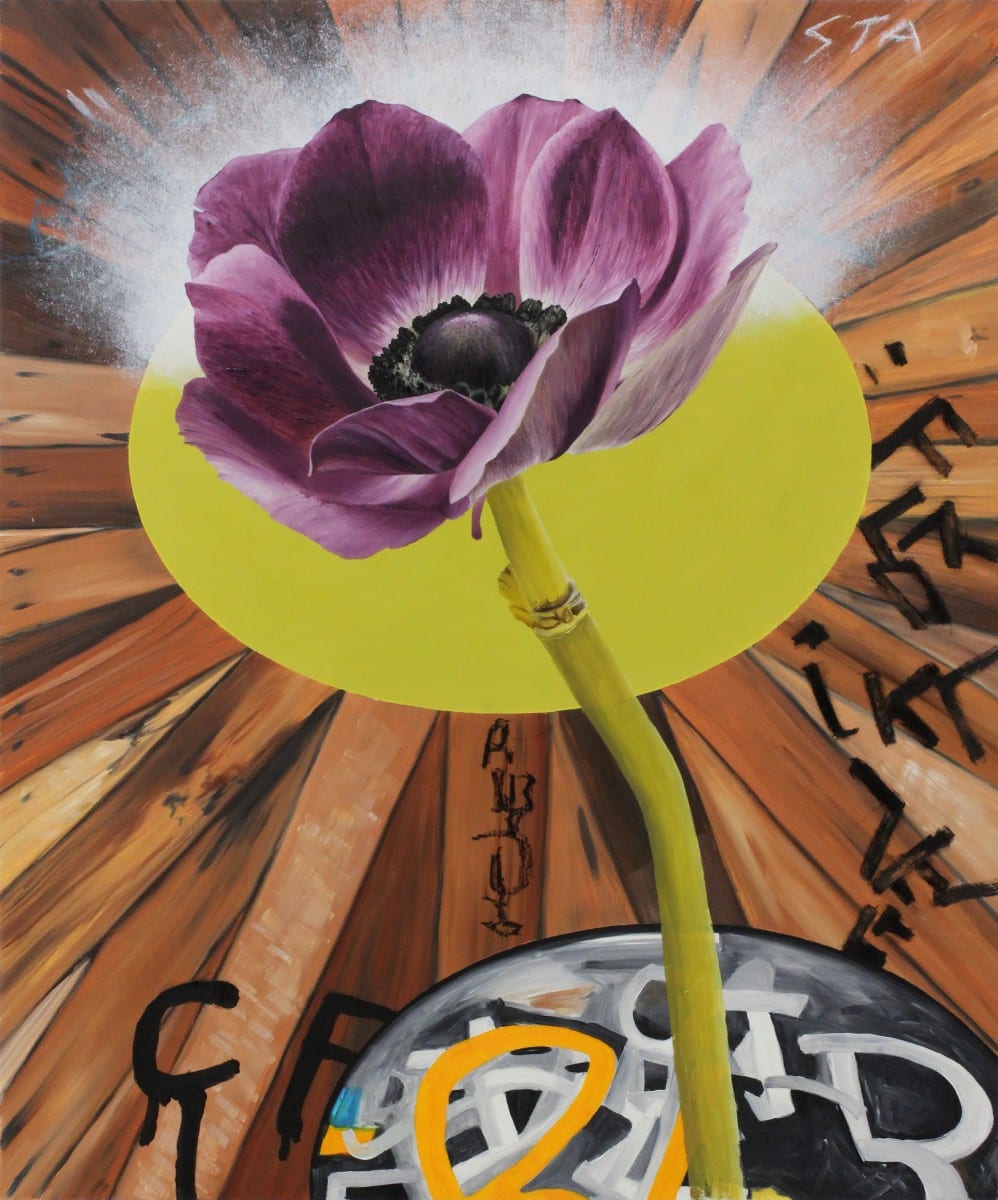An interview with Lisa Adams on the heels of her forthcoming solo exhibition “A Piebald Era” at Garis & Hahn in Downtown Los Angeles on view 12 January- 17 February 2019.
What prompted the title of the exhibition “A Piebald Era?” “Piebald” has several referents- composed of incongruous parts, different colors especially: spotted or blotched with black and white. It also has an equestrian allusion. What “piebald” are you referring to?
I’m always on the hunt for titles, in fact, I have running lists of titles. This one just appeared in my head one day, almost as if someone whispered the phrase in my ear. Then I thought, what does “a piebald era” mean? The first thing that came to mind was an image of one of my favorite paintings at the Getty, “The Piebald Horse” from about 1650 by the Dutch painter Paulus Potter. It’s a small painting with a brooding sky and a beautiful Appaloosa horse. For years I had a postcard of that painting hanging in my studio so perhaps there is a subconscious influence here. But what does an Appaloosa horse have to do with an era? So I began researching, which is something I quite enjoy and do constantly. As you’ve mentioned, I found the word has two meanings. The word “piebald” is an English word from 1580.” Pie” comes from magpie, a black and white bird, and bald, in those days meant a white spot, however, in this instance I’m referring to the word’s alternative meaning—something that is composed of incongruous parts. Suddenly it made a lot of sense to me and I interpreted the phrase as a description of the incongruous era in which we find ourselves, an era characterized by discordance and disagreement. So it begs the question, why not then just call the exhibition “An Incongruous Era? “A Piebald Era” evokes a visual thought and that’s what it’s all about for me. Ultimately the title made perfect sense.
What value does it hold in the “era” that you are defining in this body of work?
An era of incongruity expresses, among other things, a distinct period of time at odds with itself. For me, this characteristic feels chaotic, unpredictable, anxious, and at times dire. Nothing makes much sense. The work in this exhibition reflects those notions.
What has changed for you since “Petrichor?”
“Petrichor” was an exhibition entirely of small scale work where I explored some of the ideas I’ve touched on in the past. The work in the current exhibition is larger in scale and covers similar territory but seems somehow more extreme, and crazier, and yet at the same time, there is more beauty in this group of work. There are some animals and eccentric-looking structures in these paintings and I hope to include a couple of self-portraits as well if they feel right in the context of the other work.
You are now living and working in a new space. We first met at the Santa Fe Artist Colony over a decade ago and that space has greatly informed the referents you include your work. How has your new space influenced the narrative?
My new space has been a big surprise in a way I’ve never thought about before. I’m not certain the narrative in my work has been influenced but the execution certainly has. In my old space at the Santa Fe Art Colony, I had great natural light. For a painter, it is said to be the ultimate lighting condition, but I realize that may not be necessarily true. Now, I have no natural light and I use a combination of LED and halogen lighting. It has given me clarity in a way I don’t think I’ve ever experienced as the lighting is consistent. It makes a huge difference in how much detail I can see and how much less eye fatigue I experience. Working 12 continuous hours is very doable without a lot of struggle, which results in my ability to articulate more detail because I can actually see more detail. There is also another factor that can’t be overlooked about my new space, which is the lack of atmospheric particulates. Sadly, the Santa Fe Art Colony is located immediately next door to a facility that crushes concrete and asphalt for recycling. This factory generates huge amounts of airborne particulates that are unhealthy and permeated my live/workspace. The amount of material that would accumulate in my space on a weekly basis was insane. I often felt like the character in Hiroshi Teshigahara’s film “Woman In The Dunes.” With the absence of the atmospheric “filth,” everything seems clearer and lighter. I’m totally fascinated by this experience.
“The Hidden Fear of Veracity” not only makes reference to the ambiguous political climate but looks back to a work you created for “America the Beautiful” wherein an American flag is singed with the silhouette of a home. The cloaked figure wears the American flag to hide from the urban exterior, seeking refuge beneath the stars and stripes that carry a different meaning than hailing on a flag pole. Why was it important to continue the narrative of politics? What narrative are you looking to continue in these works?

I had some hesitation about painting another flag but I was compelled to do so given the conditions in which we find ourselves as a country. How could I not paint one actually? I’ve become a news junkie and either listen to or read the news the good part of every day. It was a big surprise to me that the flag painting in this exhibition looks as if it cloaks a figure underneath, as you’ve noted. That was not intentional. I was thinking more of a deflated symbol, a crumpled mess of a country but that figure reference is very dominant. I like it and it reminds me so much of certain homeless encampments downtown that prominently displays American flags as an integral part of their functional structure.
“The Flat Hope of Exile” presents another recurring motif and that is a makeshift structure nestled in a landscape removed from the familiar humdrum. The tags you incorporated from the tree stumps and graffiti first witnessed in “Albedo” return here in a whimsical “treehouse.” Complete with a satellite dish and vines miraculously supporting the structure, the treehouse seems a safe haven. Tell me about “Cody” and how this treehouse came to rise from the ashes.

I love this weird painting! That’s an old-school TV antenna, not a satellite dish. This was a structure I found and photographed at Bombay Beach on the Salton Sea. I’ve been informally photographing Bombay Beach on and off since about 2006. Initially, I knew nothing about the place and it was the name on a map that captured my imagination. Bombay Beach is a great name. Since I first discovered this tiny settlement for myself, I’ve done a lot of research and find its genesis and history fascinating. A lot has been written on it and there’s even a biennale there now. Another painting in the exhibition, “Life’s A Tickle,” includes a strange windmill structure from Bombay Beach as well. Bombay Beach and its eccentric structures, built by a handful of unconventional inhabitants, is a perfect example of an environment gone wrong and the human population that persists. In my imagination, it’s a small-scale glimpse into the larger environment of our future. In these paintings, I am more of an observer, recording my findings, and embellishing them. One of my embellishments in “The Flat Hope of Exile” is the “vines” you speak of. They are not a series of vines but rather an espalier helping to hold up the treehouse.
There are two that present a very close look at natural elements- studies of flora. Typically flowers complement structures to present a dichotomy of survival in light of the great odds of survival. These pieces seem a departure in that they are the sole focus.


The titles of these two small paintings are “The Confidence Of Fables” (the pink flower) and “The Expiration Of Icons” (the purple flower). In my 2015 exhibition “America The Beautiful,” I created a similar painting titled “The Tell” where a prominently-featured, singular flower was painted against a graffitied background. In these two recent paintings, the flowers are again painted against an environment derived from graffiti in my new neighborhood but they also have this almost angelic looking light around them. I can only imagine that this aspect of the painting is a result of my new studio lighting conditions I’ve described previously. Everything seems so crystalline it’s a little scary. The more you see, the more responsibility you have it seems. It’s hard to un-see something but maybe that’s the next step.
All images © Lisa Adams, 2019
